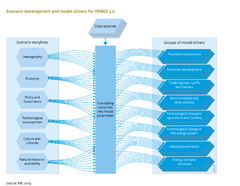Drivers: Difference between revisions
m (Text replace - "OECD Environmental Outlook to 2050 (2012)" to "OECD Environmental Outlook to 2050 (2012) project") |
Dafnomilii (talk | contribs) (Edits based on Detlef's input) |
||
| (13 intermediate revisions by 2 users not shown) | |||
| Line 1: | Line 1: | ||
{{DriverComponentTemplate | {{DriverComponentTemplate | ||
|Application=Millennium Ecosystem Assessment - MA (2005) project; OECD Environmental Outlook to 2050 (2012) project; IPCC SRES (2000) project; Shared Socioeconomic Pathways - SSP (2014) project | |||
|Application=Millennium Ecosystem Assessment project; OECD Environmental Outlook to 2050 (2012) project; IPCC SRES (2000) project; SSP project | |Overview=Framework overview; Variable overview; Policy interventions and components overview; | ||
|Overview=Framework overview; Variable overview; | |Model-Database=ENV-Growth model; MAGNET model; | ||
| | |||
|KeyReference=IPCC, 2000; OECD, 2012; MA, 2005; | |KeyReference=IPCC, 2000; OECD, 2012; MA, 2005; | ||
|ComponentCode=D | |ComponentCode=D | ||
|FrameworkElementType=driver component | |FrameworkElementType=driver component | ||
}} | }}{{#default_form:DriverComponentForm}}<div class="page_standard"> | ||
[[ | ==Description of {{ROOTPAGENAME}}== | ||
Several trends play a critical role in the future development of critical model variables and results, such as population size and economic development. For several of these, exogenous assumptions are made. These exogenous assumptions drive the outcome of model calculations, together with the endogenous functional relationships and model parameters in the model. These critical factors are referred to as drivers. In IMAGE, six groups of assumptions are distinguished that make up the scenario drivers. | |||
These six groups are the basis for all scenarios. The assumptions for the drivers are based on scenario narratives or storylines. The advantage of these narratives that consistent assumptions can be made. The narratives include cases where current trends and dynamics are assumed to continue, commonly referred to as a reference or ‘business-as-usual’ scenarios. The narratives can also describe a set of contrasting future futures for the drivers to explore the relevant range of uncertain yet plausible developments. | |||
As a rule, scenario drivers are not numerical model inputs but, in qualitative or semi-quantitative terms, govern a detailed set of exogenous assumptions in terms of model input to the various components of the model framework. Numerical model drivers for a specific scenario are established based on the six generic scenario drivers. The model drivers for the various IMAGE models and modules (called components on the site) are explained in the component pages (see [[Framework overview]]). The scenario drivers and underlying narrative, together with the quantitative model drivers, form a scenario inextricably linked with an IMAGE scenario run. | |||
</div> | |||
Latest revision as of 11:46, 8 October 2021
| Projects/Applications |
| Models/Databases |
| Relevant overviews |
| Key publications |
Description of Drivers
Several trends play a critical role in the future development of critical model variables and results, such as population size and economic development. For several of these, exogenous assumptions are made. These exogenous assumptions drive the outcome of model calculations, together with the endogenous functional relationships and model parameters in the model. These critical factors are referred to as drivers. In IMAGE, six groups of assumptions are distinguished that make up the scenario drivers.
These six groups are the basis for all scenarios. The assumptions for the drivers are based on scenario narratives or storylines. The advantage of these narratives that consistent assumptions can be made. The narratives include cases where current trends and dynamics are assumed to continue, commonly referred to as a reference or ‘business-as-usual’ scenarios. The narratives can also describe a set of contrasting future futures for the drivers to explore the relevant range of uncertain yet plausible developments.
As a rule, scenario drivers are not numerical model inputs but, in qualitative or semi-quantitative terms, govern a detailed set of exogenous assumptions in terms of model input to the various components of the model framework. Numerical model drivers for a specific scenario are established based on the six generic scenario drivers. The model drivers for the various IMAGE models and modules (called components on the site) are explained in the component pages (see Framework overview). The scenario drivers and underlying narrative, together with the quantitative model drivers, form a scenario inextricably linked with an IMAGE scenario run.
